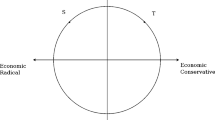Conclusion
There are several major insights which this game theoretic analysis has produced. First, we have shown that equilibria exist with substantial turnout even when both the majority is much larger than the minority and the costs of voting are exceptionally high. For example, in large electorates using the status quo rule, we show mixed-pure equilibria with turnout roughly equal to twice the size of the minority when the cost is nearly equal to 37% (e −1 × 100) of the reward (B). Second, with large electorates the many equilibria appear to reduce to just two types, the type just mentioned and a type with almost no turnout. Third, we have shown that turnout may rise as the costs of voting rise. This results when all members of a team “adjust” their turnout probabilities so that the probability of being pivotal increases to match the increased cost of voting. We have also shown that turnout is nearly invariant with costs in large electorates where turnout probabilities approach one or zero. Fourth, the actual split of the vote is likely to be a biased measure of the actual distribution of preferences in the electorate. Because majorities have greater incentives to free-ride, they will turn out less heavily than minorities. Elections can be relatively close, even when one alternative is supported by a substantial majority of the electorate. The probability that the majority will win does not seem to be closely related to the size of the electorate or its size relative to the minority. However, turnout is quite strongly correlated with the relative sizes of the minority and the majority.
Similar content being viewed by others
References
Chamberlain, G. and Rothschild, M. (1981) A Note on the Probability of Casting a Decisive Vote. Journal of Economic Theory, 25: 152–162.
Downs, A. (1957) An Economic Theory of Democracy, New York: Harper and Row.
Feller, W. (1957) An Introduction to Probability Theory and Its Applications. Vol. 1, 2nd Edition, New York: Wiley.
Ferejohn, J. and Fiorina, M. (1974) The Paradox of Not Voting: A Decision Theoretic Analysis, American Political Science Review, 68: 525–536.
and (1975) Closeness Counts only in Horseshoes and Dancing, American Political Science Review, 69: 920–925.
Ledyard, J. (1981) The Paradox of Voting and Candidate Competition: A General Equilibrium Analysis. G. Horwich and J. Quirk, eds., Essays in Contemporary Fields of Economics, Purdue University Press.
Meehl, P. (1977) The Selfish Voter Paradox and the Thrown-Away Vote Argument, American Political Science Review, 71: 11–30.
Riker, W. and Ordeshook, P. (1968) A Theory of the Calculus of Voting, American Political Science Review, 62: 25–42.
Romer, T. and Rosenthal, H. (forthcoming) Voting and Spending: Some Empirical Relationships in the Political Economy of Local Public Finance. P. Mieszkowski and G. Zodrow, eds., Provision of Local Public Services: The Tiebout Hypothesis After 25 Years, Academic Press.
Rosenthal, H. and Sen, S. (1973) Electoral Participation in the French Fifth Republic, American Political Science Review, 67: 29–54.
Schelling, T. (1960) The Strategy of Conflict, Harvard University Press.
Tucker, A. (1980) Applied Combinatorics, New York: Wiley.
Tullock, G. (1967) Towards a Mathematics of Politics, University of Michigan Press.
Wolfinger, R. and Rosenstone, S. (1980) Who Votes?, Yale University Press.
Author information
Authors and Affiliations
Additional information
We have benefited from discussion with Peter Coughlin, Terry Levesque, Peter Ordeshook, Steve Salop, and participants in the Conference. This work was supported by National Science Foundation grant DAR-7917576. We thank Glenn Benson for preparing the computer graphics and Kathy Bagwell for processing the manuscript.
Rights and permissions
About this article
Cite this article
Palfrey, T.R., Rosenthal, H. A strategic calculus of voting. Public Choice 41, 7–53 (1983). https://doi.org/10.1007/BF00124048
Issue Date:
DOI: https://doi.org/10.1007/BF00124048



